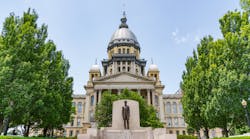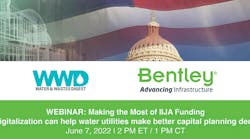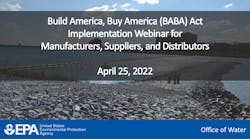U.S. EPA Press Release
On November 15, the U.S. Environmental Protection Agency (EPA) marked one year of progress in implementing President Biden’s historic Bipartisan Infrastructure Law with the release of a new report detailing the Agency’s investments in the Nation’s infrastructure and communities. The Bipartisan Infrastructure law provides EPA with more than $60 billion over five years for a wide range of environmental programs that will bring much-needed funding to America’s water infrastructure, environmental cleanups, and clean air protections, while also advancing environmental justice and combatting climate change.
The Bipartisan Infrastructure Law Year One Anniversary Report highlights how EPA is working with state, local, and Tribal partners to transform communities through the largest appropriation the Agency has ever received. EPA has already awarded $5.5 billion of the $14.1 billion available in FY 2022 through grants, contracts, and interagency agreements, and program implementation efforts and will continue to build on this progress in the coming year.
“EPA is committed to leveraging this once-in-a-generation investment to secure a future that is healthier, safer, and more just for all,” said EPA Administrator Michael S. Regan. “Over the last year, EPA has put a down payment on projects across the country that will create millions of good-paying jobs, modernize our Nation’s infrastructure, combat the climate crisis, and put us on a path to winning the 21st century. While we have our work cut out for us, the future ahead is bright and President Biden’s Bipartisan Infrastructure Law is allowing us to progress further and faster than ever before.”
Progress from the EPA’s first year of Bipartisan Infrastructure Law (BIL) investments include:
- EPA awarded $4 billion in water infrastructure funds to states, Tribes, territories, and the District of Columbia in capitalization grants under State Revolving Fund (SRF) programs. These programs provide low-cost financing for a wide range of water infrastructure projects from sewage systems to drinking water with nearly half of the funding flowing to disadvantaged communities.
- EPA awarded 20 state capitalization grants for lead service line identification and replacement. This is expected to fund approximately 300 projects in communities across the country, with nearly half of the funding flowing to disadvantaged communities.
- EPA created a $5 billion non-competitive grant program for small or disadvantaged communities to address emerging contaminants, including per and polyfluoroalkyl substances (PFAS), in drinking water systems.
- Deployed $115 million to accelerate the cleanup of Congressionally designated Areas of Concern throughout the Great Lakes region.
- Deployed $8 million through the Puget Sound Program to support tribal environmental restoration and protection projects with 19 Federally recognized Tribes.
- Deployed $40 million through the Chesapeake Bay Program to states and local stakeholders to reduce nutrients, protect small watersheds, and increase ecosystem and community resilience to climate change.
- Awarded nearly $1 billion to purchase over 2,400 electric and clean school buses in nearly 400 school districts spanning 50 states, Washington, DC, and several Tribes and U.S. territories. EPA’s Clean School Bus Program rebates help replace existing older, dirtier school buses with electric, propane, and natural gas alternatives. This will accelerate the transition to zero emission vehicles and produce cleaner air in and around schools and communities.
- Deployed more than $1 billion for cleanup activities at more than 100 Superfund National Priorities List (NPL) sites—some of the most polluted sites in the country.
- Awarded $190 million for Brownfield projects that are projected to result in over 880 site assessments, 78 sites cleaned-up, and 20,000 jobs leveraged in cleanup, construction, and redevelopment.
Every financial assistance program funded through the Bipartisan Infrastructure Law is developing a strategy to ensure at least 40 percent of the funding flows to disadvantaged communities.
As part of the Build America, Buy America Act that was passed concurrently with the Bipartisan Infrastructure Law, EPA is working to ensure that domestically sourced iron, steel, manufactured products, and construction materials are used in EPA’s infrastructure projects. Through this transformational opportunity, EPA will work to build a resilient supply chain and manufacturing base for critical products in the United States that will catalyze new and long-term investments in good-paying American jobs and businesses. As a policy priority, investing in Made in America products will position the United States to compete and lead in global markets in the 21st century.
These and other first year Bipartisan Infrastructure Law funding highlights, as well as expected results for future investments, can be found in the Bipartisan Infrastructure Law Year One Anniversary Report.
Additional Background:
The Bipartisan Infrastructure Law provides EPA over $60 billion for a wide range of programs to be made available over five fiscal years from FY 2022 through 2026:
- $14.1 billion in FY 2022
- $11.2 billion in FY 2023
- $11.6 billion in FY 2024
- $12.0 billion in FY 2025
- $12.0 billion in FY 2026
Of the $60 billion investment:
More than $50 billion are for clean water and drinking water projects along with other water protection programs, the single largest federal investment in clean water ever made. With these funds, EPA will make progress on President Biden’s pledge to replace within the decade the 6 to 10 million lead service lines still in the ground across the country, address the threat of PFAS pollution facing communities, and broaden efforts to protect critical water bodies that are important to communities and the economy.
More than $5 billion are for cleaning up longstanding pollution at Superfund and brownfields sites, and for improving waste management and recycling systems managed under the Resource Conservation and Recovery Act (RCRA) to restore the economic vitality of communities that have been exposed to pollution for far too long. Additionally, the Bipartisan Infrastructure Law reinstated and modified the Superfund chemical excise taxes. Funds collected through this tax will be available for EPA to use during the fiscal year after they are collected. As of September 30, 2022, the U.S. Treasury collected $413 million of these taxes, which EPA can apply towards Superfund cleanups in FY 2023. These funds are in addition to the $3.5 billion appropriated for Superfund cleanups in the Bipartisan Infrastructure Law.
$5 billion are for decarbonizing the nation’s school bus fleet, improving air quality for more than 25 million children who ride the bus to school each day.
$100 million are for the Pollution Prevention Program to increase access to safer and more sustainable products and services. A new grant opportunity will focus on delivering environmental justice by leveraging Safer Choice and Environmentally Preferable Purchasing as tools to increase assistance to businesses serving the needs of institutions and consumers in disadvantaged communities.
Visit EPA's Bipartisan Infrastructure Law page for more information.





